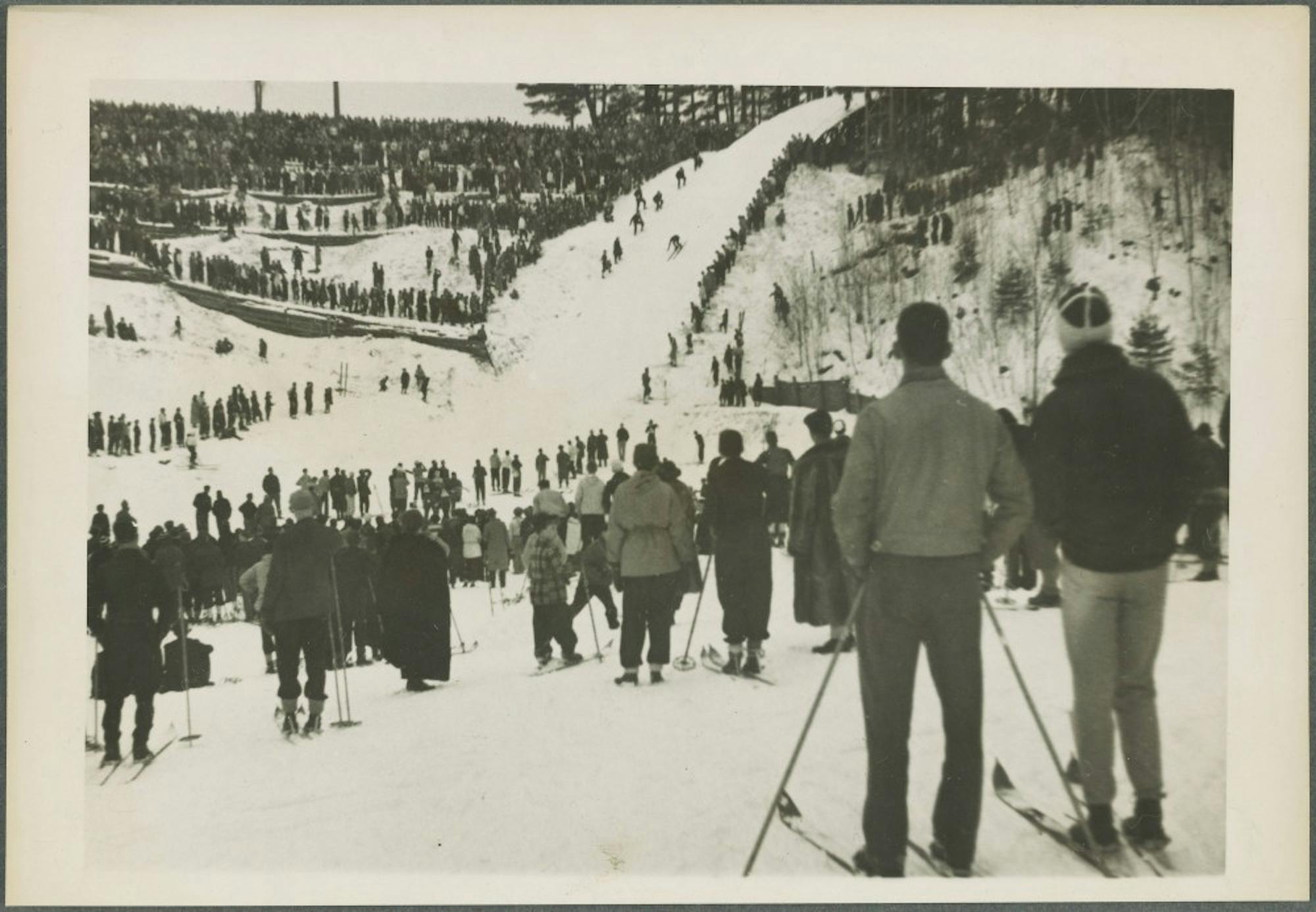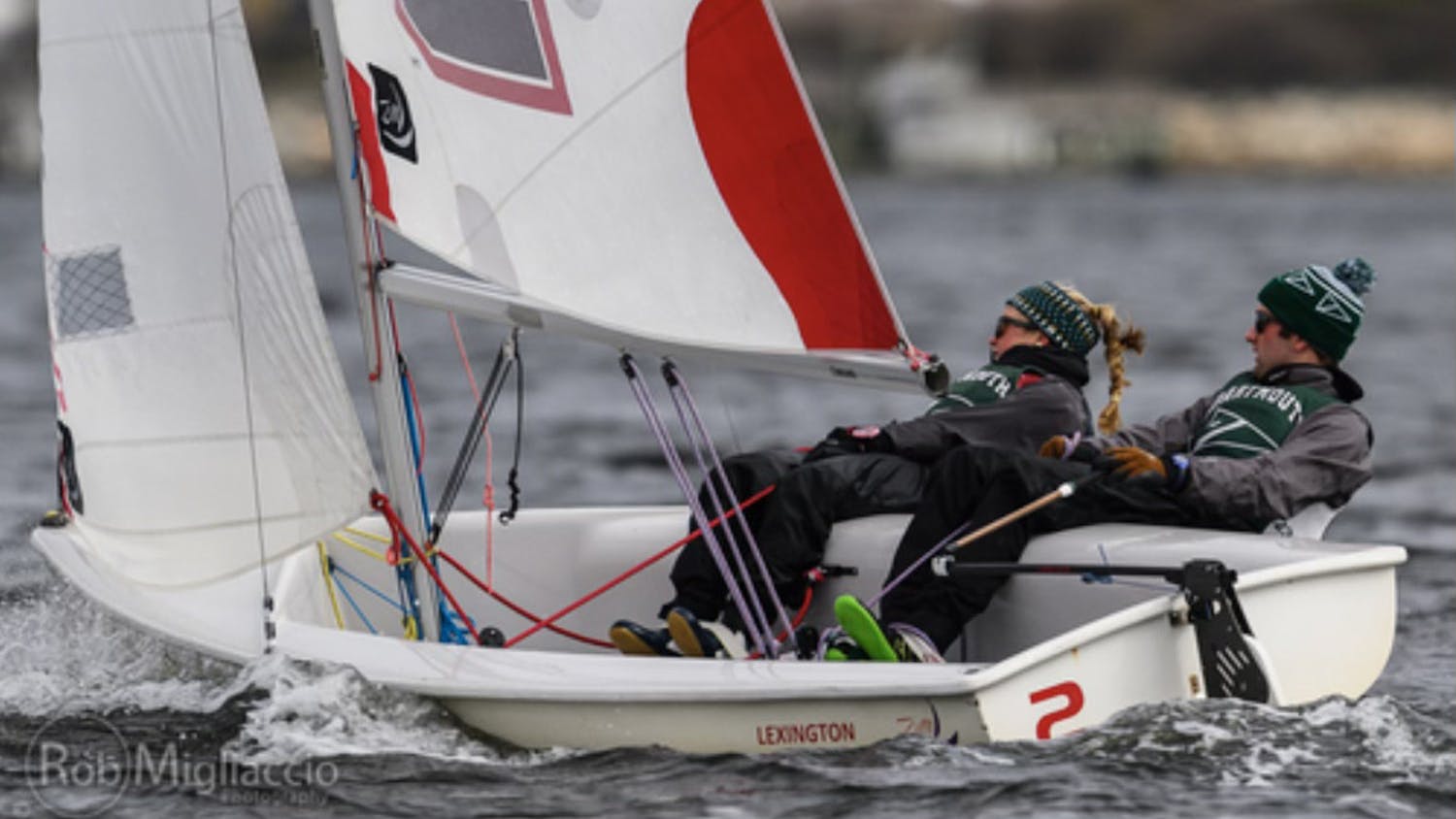For over one hundred years, Winter Carnival has descended upon Dartmouth around this time. However, recent carnivals have lacked a tradition that was long a carnival mainstay: ski jumping. In 1993, after ski jumping was no longer recognized as an intercollegiate sport, the ski jump tower that had been a prominent feature of the Hanover Country Club golf course was taken down, ending the sport’s slow demise at the College.
For years after its inception, Winter Carnival was run by the winter sports division of the Dartmouth Outing Club, and it featured various intercollegiate winter sports competitions, including skiing and speed skating.
“Ski jumping was on the last day, so everyone would go,” Putnam Blodgett ’53 Th’61 explained.
During Blodgett’s time at Dartmouth, most ski racers competed in ski jumping in hopes of winning the title of skimeister: champion of the downhill, slalom, cross-country and jumping competitions. Eventually, though, skiers started to specialize in specific events.
Blodgett also recalled the ski team being virtually all Olympians during his tenure at the College. Thus, while he enjoyed watching, he said he did not participate in the intercollegiate races.
In addition to witnessing the athletic competitions, Blodgett said he enjoyed seeing the snow sculptures every year.
“They made the sculpture now look pathetic,” he said, referencing their enormous size. “People would come from miles away to see it.”
Blodgett remembers one of the sculptures being of Eleazer Wheelock and another being of a leaning skier.
“You didn’t know if he was going to fall down or stay upright,” he said of the skier.
Blodgett also mentioned that the weather conditions in Hanover directly affected both the snow sculptures and the ski events. For a few years, there was no snow in Hanover, and they had to move the Carnival to neighboring towns. Additionally, some competitors were unhappy with the conditions even when there was snow.
“They used to have the downhill race on Moose Mountain, and one year there were these Swiss ski racers who refused to compete, so they moved it to Oak Hill,” Blodgett said. “Since the skiway opened in 1957, they’ve been there.”
Despite moving the downhill races, ski jumping took place at the golf course for the entirety of its existence.
Charlie Matt ’87 started ski jumping when he arrived at Dartmouth. He was coached by Jeff Hastings Tu ’90, a former Olympian.
“He coached for love of the sport,” Matt said.
In addition to his Dartmouth teammates, Matt ski jumped with local teenagers. They would all practice together at night on the golf course, where there were lights on the jump.
“The best jumpers were from the local area, from Norwich, they were typically 16 or 17 years old,” Matt said. “They had a whole local program and they would get some of the local bucks started at a young age.”
Though Matt had ski raced in high school, switching to jumping took some adjusting. The skis themselves were longer and wider than typical alpine skis: Matt’s were 250 centimeters long and had no edges.
“It’s a bit cumbersome,” he said.
Matt and his other teammates, who were new to the sport, learned on a smaller hill before graduating to the tower on the golf course. When they jumped off the tower, the goal was to get as far as possible in the air before landing. The skiers competed individually.
“It brought out a huge crowd. It was great fun, it really was,” Matt said. “We had people lining the whole area around the in-run of the jump.”
The students and visitors lining the jump were not just there to watch the event, though.
“You would have a whole bunch of people lined up on the hill that the skiers landed on and you would raise your arm where the person landed so the judges could tell how far down the slope people landed, so we’d have a whole bunch of undergraduates lined up along the hill,” said director of outdoor programs Tim Burdick ’89 Med’02, who volunteered as part of the DOC to help with ski jumping.
Burdick was also involved with ski jumping as a member of ski patrol.
“We had one accident my senior winter where somebody fell just as they were taking off of the jump and they kind of landed upside down on the hill and we had to transport them by snowmobile up to the ambulance,” Burdick said.
Ski jumping was declassified as a collegiate sport because it was thought to be too dangerous. Matt disagreed with this characterization of the sport.
“People think of it as being a very dangerous sport, but actually it’s not nearly as dangerous as downhill skiing, which is much less predictable,” he said.
While ski jumping no longer exists at the collegiate level, it is still an Olympic sport and exists at the middle and high school level.
“Hanover high school and middle school teams locally have a ski jump out at Oak Hill in Hanover. It’s a little bit smaller,” Burdick said. “One of the best junior ski jumpers in the country right now is from Lyme and lives here in practices a lot at Oak Hill in Hanover. Interestingly it’s alive at the junior high school and high school level and then after college, but not during college.”
Though their experiences with ski jumping were quite different, both Burdick and Matt remembered the event fondly.
“It certainly is a pretty spectacular thing to see,” Burdick said.
For Matt, ski jumping was less about trying to win medals and more about having fun.
“It was great fun,” he said, “It was good fun, and that was the intent, and there were a lot of good guys who did it, and it was kind of fun to be rubbing shoulders with guys who were Olympic caliber.”
Matt no longer ski jumps, but he continues to ski frequently in Switzerland, where he now lives.
In addition to ski jumping, events like speed skating on Occom Pond no longer exist. Burdick said he does not foresee these events returning at the intercollegiate level.
“I don’t think that the ski jumping will ever come back. I think between the risk and the cost, that’s probably gone forever. The speed skating pond, there’s some interest in that and I could see that potentially coming back some day … I can’t really imagine really serious speed skaters going and training on our compound.”




